|
All You Need To Know About Buying A BarometerThere are barometers for all purposes, tastes and budgets. Here's how to select the barometer that will suit you best. And somewhere in a very large range, there will be something that matches your desire (and wallet) in appearance and value. Barometer Or Weather Station?
A barometer is a stand alone instrument - it can hang on your wall, or be mounted in its own stand and sit on a shelf or mantel piece. You can add other instruments and incorporate them in an attractive stand or frame, or buy a two or three instrument package. A clock, or a tide clock is an excellent companion for a barometer, particularly in a matching design.
One important question to consider is where you are going to put your barometer. If it's inside, the air pressure information from the barometer will be accurate, but temperature and humidity will be of the artificial environment inside your home. Nice to know at times, but only distantly related to the weather outside. And having a matched set of instruments will add considerably to the cost.

One compromise is to opt for a "banjo" barometer. These resemble the original mercury barometers, and consist of an aneroid barometer with a circular dial at the base, and a thermometer located on the thin neck. These are attractive additions to a home's appearance, but the barometers are not always of the highest quality. But if you are more concerned about the outside weather than the inside decor, why not consider a Wireless or Home Weather Station - for about the same price as a top quality barometer you can have temperature, humidity, air pressure, rainfall and wind speed and direction information on your desk, or visible on your computer screen. But if a barometer is all you have in mind, here are a few things to think about. Buying A Barometer - First ConsiderationsThe best barometers resemble good watches in another way - the movement which controls the pointer on the dial requires the same jewels used in fine watches. This also explains why barometers can often be found in the same stores as watches and clocks. One thing in favor of barometers, though, is that they don't require batteries. Ultimately I suspect that your barometer purchase will be decided by the appearance of the instrument - after all a well designed and finished barometer can add a lot to the appearance of a room. Or boat.
I'll restrict the discussion to aneroid barometers, which combine the virtues of being attractive, accurate, relatively small, and work without requiring messy or dangerous liquids. When buying a barometer, there are two things to consider - things that make it work accurately, and the outside appearance that makes it look attractive. The latter include the type of case (usually steel or brass, although some water resistant models may be plastic), the design of the dial, and whether the movement is visible or concealed. All of these are a matter of choice, and won't affect the way the barometer works. And the word movement is a bit of an exaggeration - there are moving parts, but they move ever so slowly. So let's focus on the things that make it work, and keep it working accurately over time. The first thing to consider is the capsule. Aneroid barometers work by recording the very small movements in the thickness of a metal capsule surrounding a vacuum. As air pressure changes, the capsule either expands if the pressure is falling, or contracts if pressure is rising. These very small movements are magnified by a system of levers and related parts and transferred to the dial.
Quality Of The InstrumentIf the seal on the capsule fails, the barometer is terminally dead. And if the capsule is not perfectly uniform in thickness, the readings may not be reliable. Capsules are not difficult to make, and most are reliable, but their quality is closely related to the price and the length of the guarantee. Good barometers should come with a lifetime guarantee, or something very close to it. Allowing For Altitude The second major consideration is the elevation of the place where the barometer will be located - the height above sea level. Air pressure decreases with increasing altitude, but the actual air pressure is converted to its equivalent at sea level, both by meteorologists and on the dial of a barometer. This calibration is quite easy and is done by the manufacturer, but the formula on which it is based becomes more complex for altitudes above 3000 - 3500 feet (approximately 900 - 1070 metres). In general, barometers in stores where you live should be calibrated for that elevation. And the most common altitude ranges are from 0 - 1500' (0 - 460m) for more accurate barometers or 0 - 3500' (0 - 1070m) for barometers suitable for general home use. Some manufacturers will offer barometers which will be reasonably accurate between 3500 and 7000 feet (1070 - 2130 m) - they may cost a little more. And at least one manufacturer (Maximum) supplies barometers calibrated to your choice of 10 different altitude ranges, ending at 11,000 feet+ (3350m), and at no additional charge. Accuracy How often will you need to check your barometer? If you are unlikely to check it more than a few times a day, then a standard model from a reputable manufacturer will probably be all that you need. A good quality instrument will be able to demonstrate significant pressure changes such as those that accompany an approaching storm or hurricane. If you are a very keen weather observer, or go on long offshore boat trips, or you otherwise need to know what's happening with the weather, you may need a more accurate barometer. But there is a limit to the usefulness of pressure information from a barometer. Because there is one characteristic of the earth's atmosphere, and therefore air pressure, which affects pressure readings without providing any sort of guide to what the weather is doing or about to do. And that is the influence of atmospheric tides. 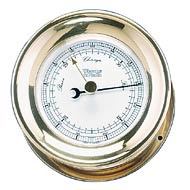
Just like the moon (and sun) influence the oceans tides, so do they influence the atmosphere. So very small variations in atmospheric pressure will happen just like oceanic tidal changes. Similarly small pressure changes occur during the day as the temperature rises and falls - the pressure drops as the temperature rises, and falls as the air cools. Normally these changes are smaller than changes due to the weather. But they are real, and they can distort the significance of changes in air pressure if you are frequently consulting a high accuracy barometer. If you want to see and record detailed air pressure changes, a cheap home weather station and appropriate computer software can do this for you, and plot it on the screen or printer. But for those who do need accuracy, select a barometer with temperature compensation. This is necessary because the heart of the aneroid barometer, the capsule, is made of metal and expands and contracts with temperature as well as air pressure. This is a different effect to the atmospheric pressure variation that occurs with air temperature changes mentioned above. It means that the capsule is changing with both temperature and pressure variations, and if we need accurate pressure information, we need to remove the effects of temperature. This is quite easily done, but adds to the cost of the barometer. Accuracy of the readings also depends on the size and scale of the dial. A small dial with a range of 4 inches of mercury (most will display the pressure in inches and millibars or hectapascals) will be hard to read with any great accuracy. But a 6" diameter dial showing a 3 inch range will be much easier to read to around .01 inches.
It becomes a matter of choice as to how great a range of air pressure you expect in a year, and how accurately you want to record it. A barometer with a four inch range will usually show pressures from 27.5 to 31.5 inches, while a 3" range will start from 28.5".
Where To Buy Your BarometerGood barometers, and not so good barometers, can be found at jewellers, clock retailers, gift shops, home decor specialists, garden speciality shops and Boating and marine dealers. Many have a good range, and the important considerations are the guarantee and the suitability of the barometer you like to the elevation of your home. You may also like to consider the internet - there are a number of internet sellers with a long history, good reputation, and often a physical shop or factory to support their sales. There are a number of Barometer makers whose quality and support are excellent - the links will take you to a recommended retailer. For range in function, style and quality it is hard to go past Weems & Plath, and has a good range. They also carry less expensive brands like West & Co and Howard Miller. An alternative is the small, very high quality range of adaptable barometers from Maximum Weather Instruments. Maximum provide excellent back up service, and so doesThe Outerbanks Weather Company, where you can expect a reasonable discount on the full range of Maximum Barometers and Weather Stations. Another source for new, used and antique barometers is eBay, and you can see what's available at this very moment by scrolling to the bottom of the page. Amazon also has an excellent range of barometers - just click on the banner at the end of this paragraph. Unlike their very competitive book section, prices on barometers may not always be the best around - for example, if you are looking for a Maximum Barometer, it's always worth checking The Outerbanks Weather Company, before activating your credit card. More About BarometersIf you would like to know a little more about what you get with a few specific barometers from Weems & Plath and Maximum Weather Instruments, just follow the links. For more information on barometers, visit the pages on the Aneroid Barometer, and Setting A Barometer. You'll find links there to other pages there which may interest you. And finally, if you are a little unsure about what the words and numbers on the dial of an aneroid barometer mean, here is a page on How To Use A Barometer. It's not as easy as you might think to use a home barometer for weather forecasting
Back to the Top, or return to the Home page. You may be interested to know that you can find out more about weather and home weather stations by receiving our newsletter ,"Watching Weather". It's published more or less weekly, and apart from tips on how to use your weather station and understand what it's telling you about the weather around you, it also covers many other weather related topics. If this sounds interesting, just add your name and email address to the form below. When you join, you'll also receive, totally free, a 20 page guide to setting up and trouble shooting problems in home weather stations. And I promise that you won't get spammed, and that your sign up details will remain totally confidential.Sign up now and receive your first issue almost immediately Barometers At eBayLots of Barometers are for sale on eBay every day - new, used and antique, good and not so good. It's always checking what's available. Even if you aren't in a buying mood, the list below shows you what's on sale at this very minute, and eBay can be a great way to learn about specific items and barometers in general. Last update 05/24/2011
|




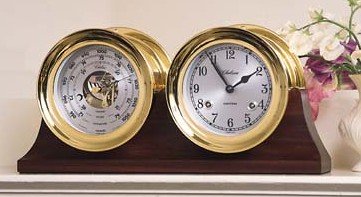 Additionally, or alternatively, you can add a thermometer or a hygrometer, which tells you the humidity. A third alternative is a combination barometer, thermometer and hygrometer, all in the same case with the values visible on the same dial. The only disadvantage of one of these is that the scale for the barometer will be smaller, and a little harder to read than a stand alone barometer.
Additionally, or alternatively, you can add a thermometer or a hygrometer, which tells you the humidity. A third alternative is a combination barometer, thermometer and hygrometer, all in the same case with the values visible on the same dial. The only disadvantage of one of these is that the scale for the barometer will be smaller, and a little harder to read than a stand alone barometer.
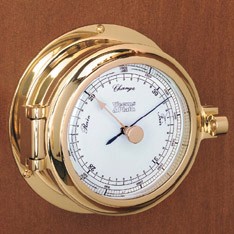 But before you select the design that pleases you the most, there are a few things to consider to make sure that the barometer does what you want it to do, which will probably be to track movements in air pressure and act as a moderately accurate weather forecaster.
But before you select the design that pleases you the most, there are a few things to consider to make sure that the barometer does what you want it to do, which will probably be to track movements in air pressure and act as a moderately accurate weather forecaster.
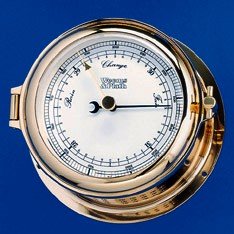
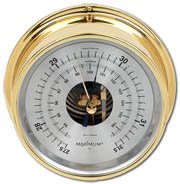 High sensitivity barometers are useful when small pressure changes need to be observed or recorded on a day to day basis, such as when a boat skipper is concerned about the approach of bad weather. These high sensitivity barometers use two capsules and are precision engineered. Movements of the capsules are more sensitive than in a single capsule model, and the scale on the dial is expanded to cover only two inches of pressure, typically from 28.5 to 30.5 inches. Over a year, there will be times when the needle goes off scale, so they are not recommended for general home use.
High sensitivity barometers are useful when small pressure changes need to be observed or recorded on a day to day basis, such as when a boat skipper is concerned about the approach of bad weather. These high sensitivity barometers use two capsules and are precision engineered. Movements of the capsules are more sensitive than in a single capsule model, and the scale on the dial is expanded to cover only two inches of pressure, typically from 28.5 to 30.5 inches. Over a year, there will be times when the needle goes off scale, so they are not recommended for general home use.